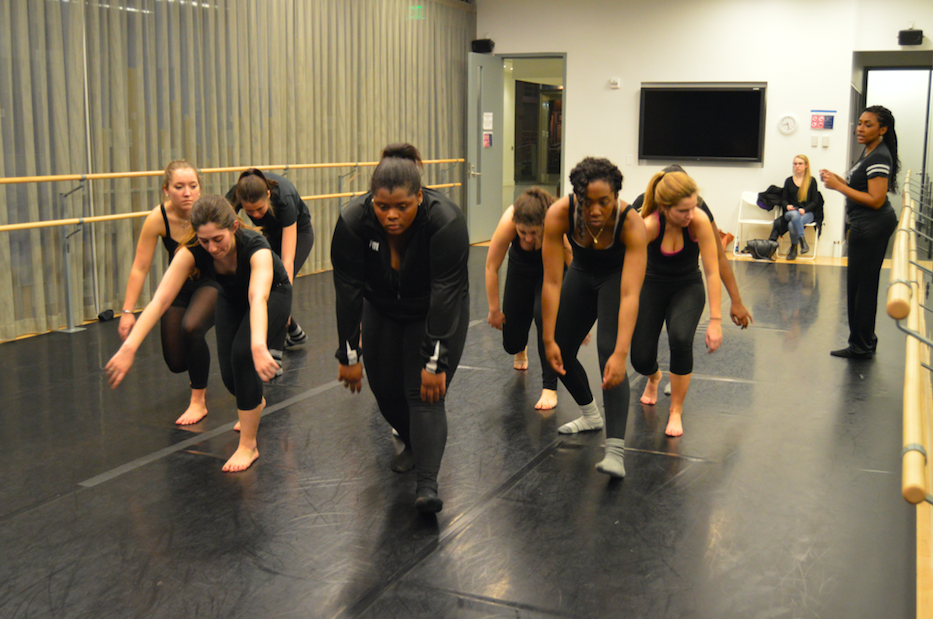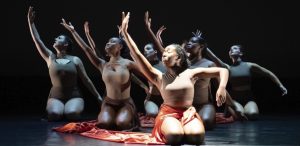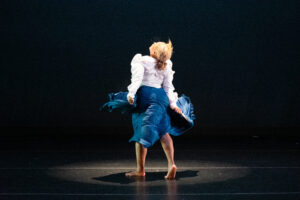At the end of her reaching arm, a single outstretched finger points up to the sky, demanding an undelivered promise. The dancer’s ascension is no solitary feat—supported by arms and backs strengthened from practice, her peers raise her far above the crowd. In powerful, broad strokes, the performers then dart across the vast expanse of stage in mere seconds—an illusion seemingly manipulating time and space itself. In these motions there is power, drama, and something one may not expect from a dance recital: a resonance of ambitions for affecting change.
Black Movements Dance Theatre’s (BMDT) spring production, Exodus, seeks to answer relevant questions in striking, unconventional methods. BMDT asks their audience to search for answers in compelling movement of both face and body, finding socio-political activism in the physical form.
“We like to tell stories—not only through our dancing but also through the entire show,” said Ashley Newman (COL ‘18), student co-director. “You’ll see that the show has a specific flow and that it goes from one end to the other, and then you feel at the end that you went through a complete journey, through a complete story.”
BMDT offers class credit for students selected through auditions and rehearses for a new performance each semester. The dances are each choreographed by a student, artistic director Professor Alfreda Davis, or a featured guest choreographer. Each piece serves as a self-contained storyline, yet the thematic ties make for a coherent performance. Exodus may not provide all the answers to the questions it raises, but it certainly allows for their exploration. The viewer is granted freedom of interpretation through thought-provoking pieces. Specifically, questions of racial inequality and exclusion from promised freedoms come to light through these dances. Newman and her co-director, Kathryn Threatt (SFS ‘18), designed Exodus to reflect the current political climate.
“Exodus comes from the idea of a mass movement to find a place, a home, that is more accepting and safe for a group of people when the place they thought was home ended up harming them,” Threatt said. “We wanted to make sure that we were talking about what was happening in our country and around the world.”
The show opens with this idea of migration. The dancers express a deliberate desire for change, each pointing in a different direction to represent the search for a more welcoming environment. Determination and urgency drive their movements—every dancer conveys the need to occupy new space by relocating throughout the stage. Set to Jack Trammell’s song “Convergence,” this piece sets the main tone before exploring its complexities.
The company makes full use of the stage with a seemingly unsustainable energy. Instead of falling back on the symmetry and conformity often found in choreography, these elements are used sparingly. The fluidity with which the dancers transition in and out of formation in their opening number gives the impression of a single-mindedness which is allowed to intermittently shatter and then merge again unscathed. This makes for a striking contrast—BMDT both dominates the stage as a singular group and highlights each dancer’s individuality in movement.
Threatt cites Charlottesville, the end of Deferred Action for Childhood Arrivals, and racial unrest as factors when considering this year’s theme. This political dissatisfaction is conveyed through dances varying in tone from borderline ferocious intensity, to piercingly melancholic reverie, and even to joyous celebration. Each dance represents the different emotions that are tied up in an unjust system, from the heartbreak and anger it produces to the joy felt in spite of it.
The members of BMDT employ both grace and strength. No part of the body goes underutilized—from the fingertips to the neck, each dancer’s entire person is fully engaged in the creation of Exodus. The performers skillfully respond to specific changes in the music and vary in their agency, from succumbing to invisible strings to abruptly fracturing conventional expectations of what should come next. There is a permeating illusion that the music moves the dancer as much as she moves in response.
“Technique is important to putting on a good show, but to be able to tell the story and leave the audience with something that inspires them to go out and change either the way they think, or the way their friends think, or change something in the world, is really what we strive to do in each show,” Newman said. “We want you to leave our concert different than when you came.”
Equally crucial to such a performance are the theatrical aspects. The dancers drive home the show’s thematic elements through their acting, engaging their facial expressions in the world-building of Exodus’ narrative. One of the more subdued performances, set to Soap and Skin’s song “The Sun,” starts with the dancers on the floor, introducing levels to their movements as they eventually rise. It is not only this transition but the frantically sorrowful facial expressions, seen in furrowed brows and downcast eyes, that make this number particularly entrancing.
Conscious artistic expression is ever-present throughout a performance both poignantly meaningful and engaging to watch. While it may seem easy for one to get caught up in the sheer beauty and athleticism of the dazzling and, at times, acrobatic dance movements, the show’s advocacy for equality manages to be read clearly through the dancers’ expressive motions.
For Threatt, this method of storytelling has long been part of BMDT’s legacy. “Our mission talks a lot about roots and where we come from and what it meant for black women on this campus to, 30 years ago, find a company for them to tell their own story and their own truth,” Threatt said.
“It stems not only from African roots, but from where dance was a whole production and told you the history of your tribe, the history of your people.”
Exodus will run Feb. 16 and 17 at 8 p.m. in the Gonda Theatre. Tickets can be purchased online at the Georgetown Performing Arts website or at the door.





